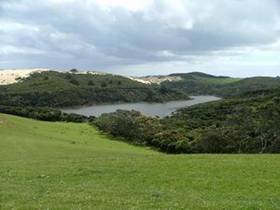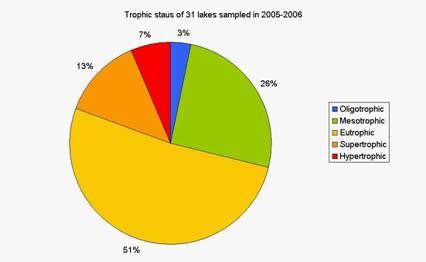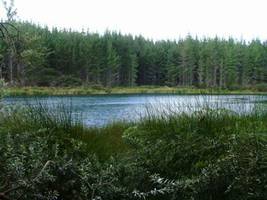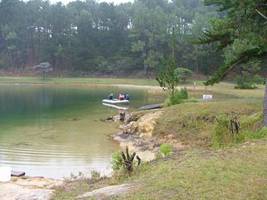Lake Water Quality Monitoring Network
Within this section…
- Water Quality Monitoring
- Summary of water quality results
- Aupouri Lakes
- Lake Carrot
- Lake Heather
- Lake Morehurehu
- Lake Ngakapua (North Basin)
- Lake Ngakapua (South Basin)
- Lake Ngakeketa North
- Lake Ngatu
- Lake Rotokawau
- Lake Rotoroa
- Lake Te Kahika
- Lake Te Paki Dune
- Lake Wahakari
- Lake Waihopo
- Lake Waipara
- Lake Waiparera
- Lake West Coast Road
- Lake Waiporohita
- Kai Iwi Lakes
- Poutu Lakes
In 2004-2005, Northland Regional Council engaged the National Institute of Water and Atmospheric Research (NIWA) to assist the council with gathering information to determine the status of 65 lakes throughout Northland.
From this, a Lake Water Quality Monitoring Network has been established, which includes 31 lakes throughout Northland. In 2005-2006 water quality monitoring on these 31 lakes, found that 71% of them are in a eutrophic state or worse (refer to page three for more information).
LakeSPI (Submerged Plant Indicators), which is used to assess the ecological condition of a lake, will be carried out on all lakes in the Network every five years. In 2005-2006, NIWA gathered ecological information on a further five lakes, as well as updating the information on six of the 65 lakes previously surveyed (refer page 9).
As recommended by NIWA in 2005, pest plant surveillance is carried out on 11 of the 31 lakes in the Lakes Water Quality Monitoring Network, for seven of these it is on an annual basis. These seven were surveyed in 2005-2006, which involves a visual inspection at all access points to the lake, such as boat ramps and beaches.

Water Quality Monitoring
All lakes in the Lake Monitoring Network are monitored four times a year. Parameters tested include secchi disk depth (water clarity), chlorophyll a (algal biomass), temperature, dissolved oxygen, pH, suspended solids (total and volatile), total nutrients (phosphorus (TP) and nitrogen (TN)) and dissolved nutrients, including dissolved reactive phosphorus, organic phosphorus, nitrate nitrogen, ammoniacal nitrogen and organic nitrogen. Temperature and dissolved oxygen are measured concurrently throughout the water column from the water surface to the lake bottom, to determine whether the lake is thermally stratified.
The life supporting capacity of a lake can be estimated using the Trophic Level Index (TLI). The four variables that are used to obtain the trophic level of a lake are secchi disk depth, chlorophyll a, total phosphorus and nitrogen as shown in the table below.
| Trophic status | Chlorophyll a (mg/m³) |
Secchi depth (m) |
Total phosphorus (mg/m³) |
Total nitrogen (mg/m³) |
| Oligotrophic | < 2 | > 7.0 | < 9 | < 157 |
| Mesotrophic | 2 – 5 | 7 – 2.8 | 9 - 20 | 157 - 337 |
| Eutrophic | 5 – 12 | 2.8 – 1.1 | 20 - 43 | 337 - 725 |
| Supertrophic | 12 – 31 | 1.1 – 0.4 | 43 - 96 | 725 - 1558 |
| Hypertrophic | > 31 | < 0.4 | > 96 | > 1558 |
Table adapted from ‘Protocols for monitoring trophic levels of New Zealand lakes and reservoirs' developed by Noel Burns, Graham Byers and Eddie Bowman in 2000.
Summary of water quality results
Overall, the annual water quality results indicate that 71% of the 31 lakes in the Network are in a eutrophic state or worse as shown in the graph below. Eutrophic lakes generally have high algal biomass, nutrients and sediment and low water clarity.

A summary of the water quality results for each of the 31 lakes sampled in 2005-2006 is presented next. The lakes are split into four main geographical areas; Aupouri and Karikari peninsulas, Kai iwi lakes and Poutu Peninsula.
Aupouri Lakes
Lake Carrot
Summer thermal stratification was observed with moderate deoxygenation (1.4 mg/L) of bottom water with higher concentrations of nutrients (TN 1160 mg/m³; TP 94 mg/m³) in relation to the upper water column (TN 707 mg/m³; TP 82 mg/m³). Water clarity is poor (secchi depth of 1.5 - 2.9 m) due to the humic-stained water. The current data suggests a eutrophic status, however bottom water nutrient concentrations are very high.
Lake Heather
The lake stratified over summer with moderate deoxygenation (1.4 mg/L) of bottom water with higher concentrations of nutrients (TN 548 mg/m³; TP 92 mg/m³) in relation to the upper water column (TN 348 mg/m³; TP 11 mg/m³). Secchi disk reading of 3.8 m indicates moderate water clarity. Secchi, nutrient and algal biomass data indicates a mesotrophic status, however bottom water nitrogen and phosphorus concentrations are high.
Lake Morehurehu
The lake stratified over summer with moderate deoxygenation (1.2 mg/L) of bottom water with higher concentrations of nitrogen (TN 635 mg/m³) compared with the upper water column (TN 286 mg/m³). Secchi, nutrient and chlorophyll a measurements (Secchi 2.7 - 3.3 m; TP 5 - 65 mg/m³; chlorophyll a 2.9 - 6 mg/m³) indicate a eutrophic status.
Lake Ngakapua (North Basin)
The lake was stratified in December with moderate deoxygenation (1.4 mg/L) of bottom water with higher concentrations of nutrients (TN 1050 mg/m³; TP 128 mg/m³) in relation to the upper water column (TN 621 mg/m³; TP 37 mg/m³). Annual average secchi disk reading of 3.0 m indicates moderate water clarity. The data suggests a eutrophic status; however, bottom water nutrient concentrations are very high.
Lake Ngakapua (South Basin)
The lake was not stratified at the time of sampling; however, stratification has been previously recorded. Secchi, nutrient and chlorophyll a measurements (secchi 3.0 -3.8 m; TN 555 – 648 mg/m³; TP 7 - 60 mg/m³; chlorophyll a 3.3 - 6 mg/m³) suggest a eutrophic status.
Lake Ngakeketa North
The lake stratified over summer with moderate deoxygenation (down to 1.3 mg/L) of bottom water with higher concentrations of nitrogen (TN 1020 mg/m³) and lower concentrations of phosphorus (TP 20 mg/m³) compared with the upper water column (TN 295 mg/m³; TP 60 mg/m³). Water clarity is poor (secchi 1.8 - 2.2 m) due to the humic-stained water. Current results suggest a eutrophic status, however bottom water nitrogen concentrations are very high.
Lake Ngatu
Thermal stratification of the lake has not been detected. Annual average secchi disk reading of 4.1 m indicates moderate water clarity. Secchi, nutrient and algal biomass data (TN 650 - 713 mg/m³; TP 41 - 61 mg/m³; chlorophyll a 0.8 - 2.3 mg/m³) indicates a mesotrophic status.
Lake Rotokawau
The lake was not stratified at the time of sampling. Secchi, nutrient and chlorophyll a measurements (secchi 2.1 - 2.5 m; TN 758 - 843 mg/m³; TP 25 - 75 mg/m³; chlorophyll a 4.8 - 6.1 mg/m³) indicate a eutrophic status.
Lake Rotoroa
Thermal stratification has not been detected in this lake. Annual average secchi reading of 3.6 m indicates moderate water clarity. Secchi, nutrient measurements and algal biomass (TN 589 - 706 mg/m³; TP 33 - 60 mg/m³; chlorophyll a 0.9 - 3.3 mg/m³) suggests a eutrophic status.
Lake Te Kahika
Thermal stratification has not been detected in this lake. Current secchi, nutrient and chlorophyll a measurements (secchi 5.6 - 6.5 m; TN 89 - 283 mg/m³; TP 1 - 93 mg/m³; chlorophyll a 1.5 - 3.6 mg/m³) suggest a mesotrophic status. Lake Te Kahika is shown in the photograph below set in a forestry catchment with a margin of emergent vegetation.

Lake Te Paki Dune
Thermal stratification has not been detected in this lake. Secchi, nutrient measurements and algal biomass (secchi 0.7 m; TN 1360 mg/m³; TP 232 mg/m³; chlorophyll a 2.6 mg/m³) suggest a supertrophic status.
Lake Wahakari
Thermal stratification has not been detected in this lake. Secchi, nutrient and chlorophyll a measurements (secchi 4 m; TN 343 mg/m³; TP 51 mg/m³; chlorophyll a 2.1 mg/m³) currently suggest a mesotrophic status.
Lake Waihopo
Thermal stratification has not been detected in this lake. Secchi, nutrient and chlorophyll a measurements (secchi 2.2 - 3.5 m; TN 663 - 726 mg/m³; TP 18 - 41 mg/m³; chlorophyll a 1.6 - 4.6 mg/m³) currently suggest a eutrophic status.
Lake Waipara
The lake was not stratified at the time of sampling. Current secchi disk reading was greater than the maximum recorded depth of 4.1 m, which indicates an improvement in water clarity compared to previous readings (2.3 m). Secchi, nutrient and chlorophyll a measurements (TN 313 - 417 mg/m³; TP 4 - 50 mg/m³; chlorophyll a 0.4 - 1.2 mg/m³) currently suggest a mesotrophic status.
Lake Waiparera
The lake was not stratified at the time of sampling. Secchi, nutrient and chlorophyll a measurements (secchi 2.4 - 2.9 m; TN 703 - 775 mg/m³; TP 8 - 73 mg/m³; chlorophyll a 3.3 - 7.5 mg/m³) currently suggest a eutrophic status.
Lake West Coast Road
The lake was not stratified at the time of sampling. Secchi, nutrient and chlorophyll a measurements (secchi > 0.5 m; TN 1390 mg/m³; TP 49 mg/m³; chlorophyll a 79.1 mg/m³) currently suggest a supertrophic status.
Karikari Lakes
Lake Waiporohita
The lake was not stratified at the time of sampling. Secchi, nutrient and chlorophyll a measurements (secchi 0.3 - 0.7 m; TN 2210 - 3020 mg/m³; TP 7 - 832 mg/m³; chlorophyll a 10 - 99.9 mg/m³) currently suggest a hypertrophic status.
Kai Iwi Lakes
Lake Kai Iwi
The lake stratified in summer with moderate deoxygenation (down to 0.5 mg/L) of bottom water and higher concentrations of nitrogen but not phosphorus (TN 570 - 1040 mg/m3; TP 35 - 70 mg/m3) in relation to the upper water column (TN 337 - 366 mg/m3; TP 11 - 74 mg/m3). An annual average secchi disk reading of 8 metres indicates good water clarity. Current data indicates a mesotrophic status; however, bottom water nitrogen and upper water phosphorus concentrations are high.
Lake Taharoa
The lake stratified in summer with moderate deoxygenation of bottom water (down to 2.2 mg/L) with higher concentrations of Nitrogen but not Phosphorus (TN 340 mg/m³; TP 11 mg/m³) compared with the upper water column (TN 102 - 166 mg/m³; TP 3 - 50 mg/m³). The data indicates an oligotrophic status.
Lake Waikere
The lake stratified over summer with anoxia of bottom water (down to 0.3 mg/L) with higher concentrations of Nitrogen but not Phosphorus (TN 727 - 1110 mg/m³; TP 9 - 17 mg/m³) in relation to the upper water column (TN 216 - 305 mg/m³; TP 5 - 83 mg/m³). A secchi disk reading of 7.2 metres indicates good water clarity. Data indicates a mesotrophic status, however bottom water nitrogen concentrations are high. The photo below of Lake Waikere, quite clearly shows the green colour of the higher algal biomass present in the lake.

Poutu Lakes
Lake Humuhumu
Summer thermal stratification was observed with moderate deoxygenation of bottom water (1.1 mg/L) with a slightly higher concentration of nitrogen (TN 421 mg/m³) compared to the upper water column (TN 292 - 299 mg/m³). Secchi, nutrient (TP 48 - 77 mg/m³) and chlorophyll a measurements (4.9 - 2.4 mg/m³) suggest a eutrophic status.
Lake Kahuparere
The lake stratified over summer with moderate deoxygenation of bottom water (1.3 mg/L) with higher concentrations of nutrients (TN 619 – 807 mg/m³; TP 53 - 80 mg/m³) in relation to the upper water column (TN 367 - 407 mg/m³; TP 18 - 27 mg/m³). Current data indicates a eutrophic status; however, bottom water nutrient concentrations are high.
Lake Kanono
The lake stratifies over summer with moderate deoxygenation of bottom water with higher concentrations of nutrients (TN 414 - 869 mg/m³; TP 18 - 66 mg/m³) in relation to the upper water column (TN 270 - 351 mg/m³; TP 11 - 47 mg/m³). Annual average secchi disk reading of 2.8 metres indicates moderate water clarity. The data suggests a eutrophic status; however, bottom water nutrient concentrations are high.
Lake Kapoai
Summer thermal stratification was observed with deoxygenation of bottom water (down to 0.5 mg/L) with higher concentrations of nutrients (TN 4740 - 8960 mg/m³; TP 440 - 917 mg/m³) in comparison to the upper water column (TN 1310 - 1980 mg/m³; TP 27 - 118 mg/m³). Annual average chlorophyll a concentrations and secchi disk reading, 40 mg/m³ and 0.76 m respectively, indicates very low water clarity. Current data suggest a supertrophic status; however, bottom water nutrient concentrations are very high.
Lake Karaka
The lake was not stratified at the time of sampling; however, stratification of the lake has been recorded previously. Annual average secchi disk reading of 2.97 m indicates moderate water clarity. Secchi, nutrient and chlorophyll a measurements (TN 257 - 536 mg/m³; TP 40 - 64 mg/m³; chlorophyll a 4.5 - 51 mg/m³) currently suggest a eutrophic status.
Lake Mokeno
Stratification was not detected in the 2005-2006 financial year; however, stratification has previously been recorded. Annual average secchi disk reading of 3.2 metres indicates moderate water clarity. Secchi, nutrient and algal biomass data (TN 450 - 606 mg/m³; TP 13 - 87 mg/m³; chlorophyll a 2.1 - 7.2 mg/m³) currently suggest a eutrophic status.
Lake Rotokawau
Summer thermal stratification was not detected during the 2005 - 2006 financial year; however, stratification has previously been observed. Current secchi, nutrient and chlorophyll a measurements (Secchi 4.3 - 5.1 m; TN 363 - 374 mg/m³; TP 5 - 26 mg/m³; chlorophyll a 2.6 - 3.8 mg/m³) suggest a mesotrophic status.
Lake Rototuna
The lake stratified over summer with moderate deoxygenation of bottom water (0.8 mg/L) with higher concentrations of nutrients (TN 998 mg/m³; TP 83 mg/m³) compared to the upper water column (TN 508 - 607 mg/m³; TP 8 - 44 mg/m³). Annual average secchi disk reading of 2 m indicates low water clarity. The data indicates a eutrophic status; however, bottom water nutrient concentrations are high.
Lake Wainui
The lake stratified over summer with moderate deoxygenation of bottom water (down to 0.5 mg/L) with higher concentrations of nutrients (TN 1570 - 3060 mg/m³; TP 213 - 476 mg/m³) in relation to the upper water column (TN 593 - 725 mg/m³; TP 13 - 94 mg/m³). Current data suggests a eutrophic status; however, bottom water concentrations of nitrogen and phosphorus are very high.
Lake Wairere
The lake stratified with moderate deoxygenation (0.5 mg/L) of bottom water with higher concentrations of phosphorus (TP 252 mg/m³) in relation to the upper water column (TP 50 mg/m³). Secchi disk readings (0.7 - 2.8 m) indicate poor water clarity and summer time chlorophyll a levels indicate algal blooms (up to 71.7 mg/m³). Secchi, nutrient (TN 413 - 1240 mg/m³) and chlorophyll a measurements suggest a supertrophic status; however, bottom phosphorus concentrations are high.
Lake Whakaneke
Stratification has not been detected in this lake. Annual average secchi disk reading of 0.8 m indicates poor water clarity. Current secchi, nutrient and chlorophyll a measurements (TN 505 - 2050 mg/m³; TP 51 - 829 mg/m³; chlorophyll a 22.8 - 154 mg/m³) indicate a hypertrophic status.
